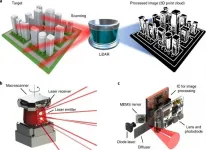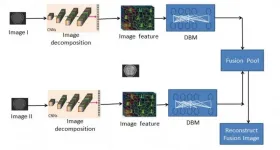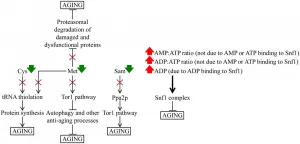(Press-News.org) Researchers at the University of California, Davis, have found a link between traffic-related air pollution and an increased risk for age-related dementia, including Alzheimer's disease. Their study, based on rodent models, corroborates previous epidemiological evidence showing this association.
Alzheimer's disease is the most common cause of age-related dementia and the sixth leading cause of death in the United States. More than 5 million Americans currently live with Alzheimer's disease -- a number that is expected to triple by 2050 as the population ages. Health care costs for those patients are predicted to grow from $305 billion in 2020 to $1.1 trillion by 2050.
UC Davis toxicologist Pamela Lein, senior author of the study recently published in Environmental Health Perspectives, said their findings underscore the urgent need to identify factors that contribute to the onset and progression of Alzheimer's to develop effective preventive measures for reducing the individual and societal burden of this disease.
Lein worked with UC Davis atmospheric scientist Anthony Wexler and first author Kelley Patten, while she was a doctoral student in the UC Davis graduate group for pharmacology and toxicology, to develop a novel approach to study the impacts of traffic-related air pollution in real time. Researchers set up a rodent vivarium near a traffic tunnel in Northern California so they could mimic, as closely as possible, what humans might experience from traffic-related air pollution.
"This approach was a creative way to get at the question of what impacts air pollution has on the brain in the absence of confounding factors such as socioeconomic influences, diet, etc.," Lein said. "It's important to know if living close to these roadways poses a significant risk to the human brain as it ages."
Exposure outcomes on the aging brain
The researchers exposed male and female rats for up to 14 months to filtered air or polluted air drawn from the tunnel and delivered it to animals unchanged in real time. The subjects were divided into two groups: wild type rats and those that express Alzheimer's disease risk genes that are relevant to humans.
Testing was conducted in 3-, 6-, 10- and 15-month-old animals using hyperspectral imaging, behavioral testing and neuropathologic measures to quantify the expression of Alzheimer's disease characteristics.
"We saw that traffic-related air pollution accelerated Alzheimer's disease characteristics not only in the animals who express the risk gene (which we anticipated) but also in the wild type rats," Lein said. "We didn't anticipate that. The big, exciting discovery is that traffic-related air pollution is a risk factor for late-onset Alzheimer's disease. This is important because this pollution is everywhere and could explain the increased number of people impacted by Alzheimer's disease across the world."
What remains unclear is which component of that pollution is predominately responsible for the effects on the brain. There are gases, particulate matter, road dust, tire wear, vibration and noise involved in traffic-related air pollution.
"The next set of studies is to try and tease apart specific components of traffic-related air pollution that drive these Alzheimer's disease traits," Lein said. "Or is it the collective mix that causes the damage?"
Fine particles (PM 2.5) in the polluted air at the study site were below federal regulatory limits, but ultrafine particles, which are not regulated, were detected in the brains of exposed animals.
"The Environmental Protection Agency only regulates down to the PM 2.5 level, but the bulk of this traffic-related air pollution is ultrafine particulate matter," Lein said. "These studies provide incentive to re-evaluate the current regulatory standards and suggest that current ones are not protective of the aging brain."
The study shows traffic-related air pollution can deliver a double whammy, decreasing the time of onset of Alzheimer's disease characteristics and accelerating disease progression. While personal factors can change an individual's risk for Alzheimer's disease (exercise, smoking, diet), people are often poor about sticking to a plan to decrease their risk factors.
"There's a lot of data that shows if you can regulate risk factors through policy at a population level, you have a more significant public health impact than if you try to regulate them at the individual level," Lein said. "If we could make some progress in identifying which component in traffic-related air pollution is causing these effects, then scientists can approach legislators to develop scientifically based regulations. Even if we can delay onset of Alzheimer's disease by five years, we could potentially save our health care system an enormous amount of money."
This study is one of four published papers to come out of the research site to date. A prior study, published in Translational Psychiatry focused on the developing brain and found a link between traffic-related air pollution and an increased risk for changes in brain development relevant to neurodevelopmental disorders such as autism.
INFORMATION:
Other study co-authors include: Kelley T. Patten and Anthony Valenzuela, UC Davis School of Veterinary Medicine; Anthony S. Wexler, Christopher Wallis, and Keith J. Bein, UC Davis Air Quality Research Center; Elizabeth Berg, UC Davis School of Medicine; and Jill Silverman, UC Davis MIND Institute and School of Medicine.
The study was supported by the National Institutes of Health.
In patients receiving therapeutic hypothermia after suffering out-of-hospital cardiac arrest, those who were cooled below 31 degrees Celsius (about 88 degrees Fahrenheit) for 24 hours showed no difference in terms of death or poor neurological outcomes at six months compared with patients receiving guideline-recommended cooling of 34 C (about 93 F). These findings are part of a study presented at the American College of Cardiology's 70th Annual Scientific Session.
Therapeutic hypothermia is a procedure in which a person's body is cooled far below normal body temperature. It has been shown to improve survival and reduce brain damage in people who have been resuscitated but remain comatose after suffering cardiac arrest (when the heart stops ...
Sperm are generally viewed as having just one action in reproduction - to fertilise the female's egg - but studies at the University of Adelaide are overturning that view.
Published in Nature Research journal Communications Biology, new research shows that sperm also deliver signals directly to the female reproductive tissues to increase the chances of conception.
Robinson Research Institute's Professor Sarah Robertson, who led the project, said: "This research is the first to show that the female immune response is persuaded by signals in sperm to allow the male partner ...
Marilyn Monroe famously sang that diamonds are a girl's best friend, but they are also very popular with quantum scientists - with two new research breakthroughs poised to accelerate the development of synthetic diamond-based quantum technology, improve scalability, and dramatically reduce manufacturing costs.
While silicon is traditionally used for computer and mobile phone hardware, diamond has unique properties that make it particularly useful as a base for emerging quantum technologies such as quantum supercomputers, secure communications and sensors.
However there are two key problems; cost, and difficulty in fabricating the single crystal diamond layer, which is smaller ...
The nanophotonics-based LiDAR technology developed by a POSTECH research team was presented as an invited paper in Nature Nanotechnology, the leading academic journal in the field of nanoscience and nanoengineering.
In this paper, a POSTECH research team (led by Professor Junsuk Rho of the departments of mechanical engineering and chemical engineering, postdoctoral researcher Dr. Inki Kim of the Department of Mechanical Engineering, and Ph.D. candidate Jaehyuck Jang of the Department of Chemical Engineering) in cooperation with the French National Science Institute (CNRS-CRHEA) focused on the LiDAR device developed through studying the metamaterials based ultralight nanophotonics.
In addition, the paper ...
Image fusion is a process that can enhance the clinical value of medical images, improving the accuracy of medical diagnoses and the quality of patient care.
Researchers at the College of Data Science Software Engineering at China's Qingdao University, have developed a new 'multi-modal' image fusion method based on supervised deep learning that enhances image clarity, reduces redundant image features and supports batch processing. Their END ...
ATS 2021, New York, NY - The COVID-19 pandemic has, and will continue to have, a tremendous impact on ICU nurses' mental health and willingness to continue in the critical care work force, according to research presented at the ATS 2021 International Conference.
Jill Guttormson, PhD, RN, associate dean for Academic Affairs and associate professor, College of Nursing, Marquette University, and colleagues sought to describe the impact of COVID-19 on ICU nurses through a survey using valid and reliable measures of burnout, moral distress, depression, anxiety, and posttraumatic stress symptoms.
The researchers recruited a national sample of nurses who have worked in the ICU during the COVID-19 pandemic between October and ...
The cover for issue 7 of Oncotarget features Figure 14, "A hypothetical model of how a specific remodeling of cellular metabolism by CR slows down yeast chronological aging," published in "Caloric restriction creates a metabolic pattern of chronological aging delay that in budding yeast differs from the metabolic design established by two other geroprotectors" by Mohammad, et al. which reported that caloric restriction and the tor1Δ mutation are robust geroprotectors in yeast and other eukaryotes.
The authors demonstrate that caloric restriction generates a unique metabolic pattern.
Unlike the tor1Δ mutation or lithocholic acid, it slows down the metabolic pathway ...
A team of McMaster University researchers who studied heart patients found that stair-climbing routines, whether vigorous or moderate, provide significant cardiovascular and muscular benefits.
The findings, published in closely related studies in the journals Medicine & Science in Sports & Exercise and Frontiers, address the most frequently cited barriers to exercise: time, equipment and access to gym facilities.
"Brief, vigorous stair-climbing and traditional moderate intensity exercise both changed fitness, which is a key predictor of mortality after a cardiac event," says Maureen MacDonald, one of the lead researchers on both studies and a professor in McMaster's Department ...
Oncotarget published "The cancer testis antigens CABYR-a/b and CABYR-c are expressed in a subset of colorectal cancers and hold promise as targets for specific immunotherapy" which reported that Calcium-binding tyrosine phosphorylation-regulated protein is expressed in the human germ line but not in adult human tissues, thus, it is considered a cancer testis protein.
The aim of this study is to evaluate the CABYR isoforms: a/b and c mRNA expression in colorectal cancer and to determine if these proteins hold promise as vaccine targets.
CABYR mRNA expression in a set of normal human tissues, including the testis, were determined ...
A rare syndrome has been observed in people following vaccination against Covid-19. This involves thrombosis at unusual sites in the body, associated with a low thrombocyte (blood platelet) count and a clotting disorder. In medical jargon, this syndrome is referred to as VITT (vaccine-induced thrombotic thrombocytopenia). Doctors at the Department of Medicine I of MedUni Vienna and Vienna General Hospital (Division of Hematology and Hemastaseology) have now successfully treated an acute instance of this syndrome.
VITT is most probably caused by a defective immune response, whereby thrombocyte-activating antibodies are produced resulting ...





